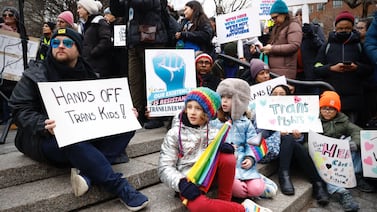A Michigan student threatened to kill his ex-girlfriend at school. Another posted on social media that he planned to vandalize cars at the prom and would shoot any “snitches.”
Police intervened in both cases before harm was done, thanks to the state’s confidential OK2SAY tipline, which logged 3,742 calls, texts, and emails reporting school threats last year and nearly as many in the three weeks since the deadly shooting at Oxford High School.
It’s impossible to say how many of those threats would have been carried out if not for the tipline, but state police believe OK2SAY has stopped suicides, assaults, vandalism, and worse.
School safety experts say anonymous tiplines are among the most effective tools for preventing school violence, including mass shootings like the one that took four lives and injured seven last month at Oxford High School.
Just over half of the public middle and high schools in the U.S. have tiplines, according to the U.S. Department of Justice. The most successful ones have coordinated, trained, expert teams prepared to respond quickly and appropriately, the department said in an April report.
“I absolutely believe if we did not have the OK2SAY tipline we would have had a school tragedy like Oxford a long time ago” in MIchigan, said Lt. Colonel Chris Kelenske, deputy director of state police who supervises the Office of School Safety.
OK2SAY is Michigan’s only statewide tipline. School districts do not sign up to participate but some are better than others at promoting it. Anyone can call. A few school districts have their own local tiplines, Kelenske said, but those aren’t staffed 24 hours a day by trained responders like OK2SAY.
Citing the ongoing investigation, Kelenske declined to say whether OK2SAY received any tips about Oxford in the days and hours before the shooting.
But in the 18 hours after, OK2SAY received a record number of more than 2,000 tips, Kelenske said. About 1,000 more have rolled in since then. Calls typically escalate after shootings — even when the violence happens in other states — because people are on high alert as news reports inspire copycat threats, he said. Copycat threats have caused more than 100 school closures in Michigan this month.
Threats are continuing, and law enforcement is taking them seriously.
For example, a 15-year-old was arrested this month, ordered not to return to school, and outfitted with a GPS monitoring device after police investigated an OK2SAY tip that the student had threatened violence at Bloomfield Hills High School.
Another 15-year-old was arrested in Oakland County after an OK2SAY tipster reported that the boy had said he would “shoot up” Lake Orion High School if he could get a gun.
Ninety percent of school shooters displayed warning signs, said Michael Planty, director of the Center for Community Safety and Crime Prevention at the Research Triangle Institute, a North Carolina-based research institute whose scientists study technology’s role in solving critical problems.
“They revealed information about their plans days or weeks before carrying out the actual attacks. People knew, whether siblings or other students,” said Planty, a former Department of Justice researcher who studies victimization, crime prevention, and school safety.
OK2SAY is monitored around the clock by technicians trained to assess the urgency of calls and route tips to responders best equipped to handle them. Last year, OK2SAY routed 1,004 tips to school officials; 460 to local law enforcement; 379 to online resources, counseling or crisis lines; 95 to Child Protective Services; and one to mental health services.
OK2SAY was established by the state Legislature as a tool for anonymous reporting of tips about school-related crimes, or potential harm to safety of students, teachers, and staff. Since then, more than 29,000 tips have rolled in via phone, text and email. The program initially was housed in the Department of the Attorney General but now is managed by the Michigan State Police.
According to the program’s 2020 annual report, half of the cumulative tips have related to suicide and bullying, while 1,046 related to planned school attacks. The report does not include calls made after the Oxford shooting.
Students shouldn’t hesitate to call if they hear something concerning, Kelenske said.
“Saving your friend’s life is not betraying your friend,” Kelenske said. “If they did not say anything and something happened, how would that make them feel knowing they could have potentially done something.”
Anything concerning is worth reporting when it comes to school safety, said Brian Gard, founder of School Safety Associates, a national consulting firm based in west Michigan.
“If there’s any doubt, if there’s any hesitation” that it might not be a credible threat, report it anyway, he said. “It might be one pice of a puzzle, and somebody else might just make a tip that is another piece of the puzzle, and the person investigating might put these two things together” and be able to avert a threat to safety.
A tipline is only as effective as its marketing, Planty said. Students need to be aware of the tipline, and they need to know how to use it so they provide sufficient information for schools and law enforcement to follow up, he said. Students also need a school culture that supports reporting threats and concerns about safety, he said.
“The problem is that school culture often doesn’t allow students to provide this information. It comes across as snitching that will get them or someone else into trouble,” he said. “They need a school climate that’s there for them to feel safe, and they need to know that when they put in a tip it will be acted upon.”
That means tiplines need to be properly staffed, especially at times of high call volume, such as after a high profile attack like the Oxford shooting.
“When there’s a shock to the system people become hyper vigilant” and call in more tips, Planty said. “People feel more compelled and empowered to report.”
Door security, window locks, visitor screening, and well rehearsed lockdown drills also help. Gard also recommends that every classroom have an emergency backpack with a first aid kit, a whistle, high-visibility vests to identify teachers, and name tags to help with reunification of young children after an evacuation.
“It’s really important to focus on prevention and identification of threats, but if things do happen, schools need to be prepared,” Planty said.
OK2SAY costs about $1.1 million a year to operate. It is modeled after Colorado’s Safe2Tell program created after the Columbine High School shooting, where 15 people were killed and dozens were injured. According to the Colorado program’s website, the aim was to penetrate the “code of silence” that keeps students in fear of being labeled a “snitch” or of being targeted by the person they report.
(Editor’s note: This story has been updated to correct the title for Michael Planty, the director of the Center for Community Safety and Crime Prevention at the Research Triangle Institute.)







